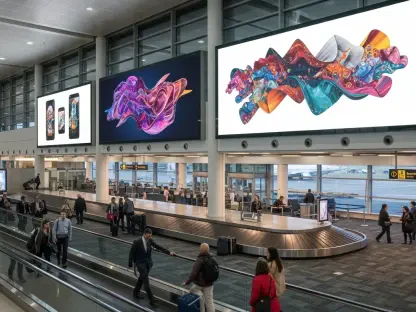The landscape of programmatic advertising is evolving at a rapid pace, driven by technological advancements, changing privacy regulations, and shifting consumer expectations. As we look ahead to 2025, industry experts predict significant transformations that will redefine how advertisers and publishers operate within this dynamic ecosystem. This article delves into the key trends and predictions for programmatic advertising, drawing insights from leading executives across the industry.
Data-Driven Addressability and First-Party Data
Embracing First-Party Data and Privacy-Safe Solutions
As privacy regulations continue to evolve and third-party cookies become obsolete, the importance of first-party data is becoming increasingly evident. Brands must adapt by leveraging first-party data and implementing privacy-safe solutions such as data cleanrooms. These cleanrooms facilitate secure collaboration between brands and data providers while ensuring consumer privacy is maintained. Ari Brandt from Unity emphasizes that data and addressability will be central to future programmatic advertising, highlighting the need for precision in targeting solutions to avoid wasted ad spend and reduce the environmental impact.
The shift towards first-party data is not only a technical necessity but also a strategic advantage. With third-party cookies being phased out, brands that can effectively harness their own data will be better positioned to deliver personalized, relevant advertisements. Tools like data cleanrooms allow for collaboration while keeping consumer information secure and compliant with evolving privacy laws. This approach ensures that brands can continue to target their audiences effectively without compromising on privacy, which is an increasingly critical factor in consumer trust and brand loyalty.
Transparency and Consumer Trust
Transparency and consumer trust are paramount in the programmatic advertising landscape. Innovations such as AI-enhanced contextual targeting and advanced first-party data strategies will play a crucial role in maintaining privacy compliance and building consumer trust. Frederic Liow from AlgoriX underscores the importance of these innovations in ensuring that advertising efforts are both effective and respectful of consumer privacy. As the industry moves toward a more privacy-conscious approach, brands must prioritize transparency and trust to succeed in the evolving ecosystem.
In response to growing consumer awareness and regulatory changes, companies must demonstrate a commitment to transparency. This involves clear communication about how data is collected, used, and protected. AI-enhanced contextual targeting offers a way to serve relevant ads without relying on invasive tracking methods. By leveraging first-party data, brands can ensure their campaigns are not only compliant with regulations but also aligned with consumer expectations. Building trust through transparency and ethical data practices will be a cornerstone of successful programmatic advertising strategies in the coming years.
AI-Driven Curation and Personalization
Predictive Analytics and Real-Time Targeting
Artificial intelligence (AI) is revolutionizing programmatic advertising by enabling predictive analytics, real-time targeting, and automated creative optimization. These advancements enhance the effectiveness and efficiency of ad campaigns, allowing brands to reach the right users at the right time. Amir Sharer from BRAVE highlights the indispensable role of AI in safeguarding consumer privacy while optimizing ad performance. Conor Donnelly from MobileFuse adds that cross-platform measurement capabilities further enhance predictive analytics, enabling seamless optimization across various screens.
The integration of AI into programmatic advertising is paving the way for more precise and impactful campaigns. Predictive analytics allows advertisers to anticipate user behavior and preferences, making it possible to tailor ads in real-time. This ensures that the right message reaches the right audience at the most opportune moment. Cross-platform measurement capabilities mean that AI can fine-tune these predictions and optimizations across multiple devices and channels, providing a cohesive and effective user experience. This level of targeting not only improves ad performance but also enhances user engagement and satisfaction.
Automated Creative Optimization
AI-driven automated creative optimization is becoming increasingly significant in programmatic advertising. By leveraging AI, brands can personalize ad content in real-time, ensuring that each user receives a tailored experience. Alex Jacobson from Media.net points out that advanced targeting capabilities driven by AI will lead to significant outcomes by efficiently reaching the right users. Dror Ben Yishai from IntentIQ emphasizes the evolution of SSPs into data platforms, facilitating sophisticated audience segmentation and targeting within their ecosystems.
The capacity of AI to dynamically adjust ad content based on user interactions is a game-changer for personalization. Automated creative optimization means ads can be customized on the fly, reflecting the unique preferences and behaviors of each user. This level of personalization increases the likelihood of engagement and conversion, providing a better return on ad spend. SSPs evolving into comprehensive data platforms enable deeper audience insights and more precise segmentation, ensuring that ad delivery is not just efficient but also highly relevant to the target audience.
Programmatic Technologies Driving Innovation
AI-Powered Automation and Privacy-First Identity Solutions
Key technologies driving innovation in programmatic advertising include AI-powered automation, privacy-first identity solutions, and advanced bidding algorithms. Jose Macías from Azerion explains that AI, machine learning, contextual targeting, and privacy tools will optimize targeting and measurement while respecting user privacy. Anthony Flaccavento from Ogury adds that the evolution of ad tech, heavily influenced by AI and machine learning, has transformed large-scale bidding and optimization, unlocking new insights from complex data.
The use of AI and machine learning in programmatic advertising is unlocking unprecedented levels of efficiency and insight. AI-powered automation streamlines the process of buying and placing ads, making it more responsive to real-time data and market conditions. Privacy-first identity solutions are essential in this new landscape, providing ways to identify and target users without compromising their privacy. These tools ensure compliance with stricter privacy regulations while still enabling effective and personalized advertising. Advanced bidding algorithms further enhance this by maximizing the value of each ad impression through real-time optimizations.
Advanced Supply Path Optimization
Advanced Supply Path Optimization (SPO) is set to redefine ad placement as a data-driven, performance-focused process. Amir Sharer from BRAVE highlights that SPO will streamline the supply chain, reduce ad waste, and secure premium inventory. This optimization ensures maximum efficiency and return on investment (ROI) for advertisers. Dror Ben Yishai from IntentIQ adds that identity solutions, privacy tools, and curation platforms will drive innovation, balancing personalization with consumer trust.
Supply Path Optimization is revolutionizing the ad supply chain by prioritizing the most efficient and transparent paths to inventory. This reduces the number of intermediaries, minimizing fraud, and maximizing the value of each ad placement. By using data to inform these decisions, SPO ensures that advertisers can achieve their goals more effectively. The focus on premium inventory means that ads are more likely to be placed in high-quality, relevant contexts, improving both their impact and user experience. Privacy tools and curation platforms are critical in this process, ensuring that optimization efforts do not come at the cost of consumer trust or compliance.
Emerging Programmatic Channels for Growth
Connected TV (CTV) and In-Game Audio Ads
Connected TV (CTV) is poised to become a significant channel for programmatic advertising growth. Juanma Alvarez from Equativ emphasizes the importance of improved content metadata and automatic content recognition (ACR) in enhancing audience segmentation and scaling capabilities. Additionally, non-intrusive in-game audio ads provide innovative monetization options, integrating seamlessly into gameplay and enhancing user experiences. Frederic Liow from AlgoriX highlights the potential of in-game audio ads to improve targeting precision and ad timing.
The growth of Connected TV represents a major opportunity for programmatic advertising. As more viewers shift to streaming platforms, the potential for targeted, relevant ads increases. Enhanced content metadata and ACR technology allow advertisers to understand and segment audiences more precisely, ensuring that ads are highly relevant. In-game audio ads offer a novel way of engaging users without disrupting their experience, making monetization more seamless and effective. These audio ads can be perfectly timed and contextually relevant, enhancing the overall user experience while providing valuable advertising opportunities.
Cross-Platform Messaging and Programmatic Audio
Cross-platform messaging strategies are essential for integrating key channels such as CTV, Digital Out-Of-Home (DOOH), and mobile. Ari Brandt from Unity underscores the need for cohesive messaging across these platforms to maximize impact. Programmatic audio is also expected to grow, driven by the popularity of podcasts, music streaming, and voice-activated devices. Amir Sharer from BRAVE notes that programmatic audio will enrich visual programmatic campaigns and enable brand storytelling.
The ability to deliver a consistent message across various platforms is crucial for modern advertising campaigns. Integrating channels like CTV, DOOH, and mobile ensures that audiences receive a unified and coherent brand message, regardless of where they are engaging. This multi-channel approach enhances the effectiveness of campaigns and increases user reach. Programmatic audio, driven by increasing consumption of podcasts and music streaming, adds a powerful auditory dimension to advertising strategies. By blending visual and audio elements, brands can create richer and more immersive storytelling experiences, engaging users in multiple ways and deepening brand connections.
Evolving Expectations of Advertisers and Publishers
ROI-Driven Metrics and Sustainability
Advertisers and publishers are increasingly prioritizing ROI-driven metrics such as sales lift and customer lifetime value over traditional key performance indicators (KPIs). Amir Sharer from BRAVE highlights the growing importance of sustainability, with an emphasis on low-carbon ad placements. These new priorities reflect a shift towards more meaningful and impactful measures of success in advertising campaigns.
The focus on ROI-driven metrics signifies a more strategic approach to advertising investments. Metrics like sales lift and customer lifetime value provide a clearer picture of the long-term impact of ad campaigns. This shift away from traditional KPIs towards more meaningful outcomes ensures that advertising efforts are not only efficient but also effective in driving real business results. In addition to these financial metrics, sustainability is becoming a key consideration. Low-carbon ad placements and other environmentally conscious practices are being prioritized, reflecting a broader commitment to responsible and sustainable advertising practices.
Transparency and Efficiency
As privacy regulations tighten and consumers become more aware of their data rights, the demand for transparency and efficiency in programmatic advertising is growing. Jose Macias from Azerion explains that advertisers are seeking clear, efficient solutions that provide transparency in the ad supply chain. Publishers are focusing on maximizing revenue through effective monetization strategies while maintaining compliance with privacy laws. Frederic Liow from AlgoriX adds that accountability and alignment with brand values are crucial for both advertisers and publishers moving forward.
In an era of increasing scrutiny, transparency is not just a regulatory requirement but also a competitive advantage. Advertisers need to know where their ads are placed and how they are performing, while consumers want assurance that their data is being handled responsibly. Efficiency in the ad supply chain helps eliminate waste, reduce costs, and improve overall campaign performance. For publishers, effective monetization strategies that align with privacy laws are essential to maintaining both compliance and audience trust. This dual focus on transparency and efficiency will be critical for navigating the evolving landscape of programmatic advertising.
Conclusion: Shaping the Future of Programmatic Advertising
The landscape of programmatic advertising is rapidly transforming, fueled by advancements in technology, evolving privacy regulations, and shifting consumer expectations. By 2025, industry experts anticipate sweeping changes that will significantly alter how advertisers and publishers navigate this dynamic ecosystem. This article explores the key trends and predictions shaping the future of programmatic advertising, with insights from leading industry executives.
One major development is the increasing reliance on artificial intelligence (AI) and machine learning to optimize ad placements and target the right audiences more effectively. These technologies are expected to provide deeper insights into consumer behavior, enhancing the precision and efficiency of ad campaigns.
Privacy regulations are also playing a pivotal role in reshaping the industry. With stricter laws aimed at protecting consumer data, advertisers will need to adopt more transparent practices and prioritize user consent. This shift is expected to foster greater trust between consumers and brands, ultimately leading to more meaningful and personalized advertising experiences.
Additionally, the rise of connected devices and the Internet of Things (IoT) is expanding the reach of programmatic advertising. Advertisers will be able to target consumers across a wide array of devices, from smart TVs to wearable technology, creating more opportunities for engagement.
As we approach 2025, the programmatic advertising landscape will undoubtedly undergo significant transformations. Advertisers and publishers who stay ahead of these trends and adapt to the changing environment will be best positioned for success in this ever-evolving industry.









